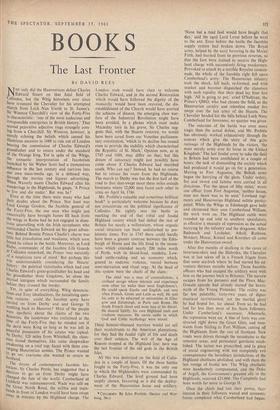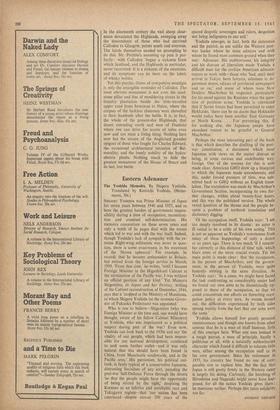BOOKS
The Last Frontier
BY DAVID REES NOT only did the Hanoverians defeat Charles Edward Stuart on that fatal field of Culloden, but the Whig historians ever since have trounced the Chevalier for his attempted march from Loch Nan Uamh to St. James's. Sir Winston Churchill's view of the Forty-Five is characteristic: `one of the most audacious and irresponsible enterprises in British history.' That second pejorative adjective rings strangely com- ing from a Churchill. Sir Winston, however, is Merely echoing the beliefs which caused his illustrious ancestor in 1688 to ride out of London bearing the commission of Charles Edward's grandfather and to return under the standard Of the Orange king. Yet in spite of the Whigs, the romantic interpretation of Jacobitism launched by Sir Walter Scott had a tremendous influence in the last century and survives into our own mass-media age, in a debased way, through the movies and liqueur advertising. When Waverly meets Charles Edward after his wanderings in the Highlands, he gasps, 'A Prince to live and die under.' But was he?
Even at the time there were many who had their doubts about the Prince. Not least was Lord George Gordon, the Jacobite general of the Forty-Five, the one man who might just conceivably have brought James III back from the wings in Rome had he not engaged in disas- trous quarrelling with the Irish sycophants who surrounded Charles Edward on his great adven- ture. Behind Bonnie Prince Charlie's charm was little but irresolution and weakness, which soon found its solace in the bottle. Moreover, as Lord
ieho, commander of the Jacobite Life Guards at Culloden remarked, the Prince 'was naturally of a suspicious turn of mind.' But perhaps this was understandable considering the Stuarts' history: the political vicissitudes which had cost Charles Edward's great-grandfather his head and his grandfather three kingdoms, let alone the Myriad intrigues which surrounded the family before they crossed the border.
Yet, in spite of everything, Whig denuncia- tions and Tory idealisations, the tantalising ques- tion remains: could the Jacobite army have carried on from Derby and sent George II scuttling back to Hanover? Most of 'the people Were apathetic about the claims of the two dynasties; the landowner who exclaimed at the time of the Forty-Five that he minded not if the devil were King so long as he was left in Peacefld possession of his estates was typical. At Derby, 120 miles from Whitehall, the clans- Men found themselves, like some sleepwalker awakening on .a roof top, faced with three con- ,verging Hanoverian armies. The Prince wanted IO go on; everyone else wanted to return to Scotland.
The doyen of contemporary Jacobite his- torians, Sir Charles Petrie, has suggested that a decision to go on from Derby might have hanged the fate of the world. Cumberland at ,1-ichfield was outmanceuvred, Wade was still on ;he Great North Road, the militia and train- °ands in front of London would have been swept away in minutes by the Highland charge. The
London mob would have risen to welcome Charles Edward, and in the second Restoration which would have followed the dignity of the monarchy would have been restored, the dis- establishment of the Church would have averted the schisms of dissent, the emerging class war- fare of the Industrial Revolution might have been avoided. In a phrase which must make Macaulay turn in his grave, Sir. Charles sug- gests that, with the Stuarts restored, we would have been saved from our Venetian parliamen- tary constitution, 'which in its decline has ceased even to provide the stability which characterised the Republic of St. Mark.' Opinion now, as in 1745 and 1688, may differ on that; but this dream of autocracy might just possibly have come about if Charles Edward had marched south. Who can say? Instead, he had no course but to retrace his route from the Highlands. The march to Derby was but the first half of the road to that sleet-swept moor three miles outside Inverness where 12,000 men faced each other in arms on April 16, 1746.
Mr. Prebble's valuable and sometimes brilliant book* is particularly welcome because he does not concentrate on the political significance of Culloden. He rightly secs the battle as marking the end of that tribal and feudal Highland society which had defied the rest of Britain for nearly a millennium, whose organic social structure ran back undisturbed to pre- historic times. For in 1745 there could hardly have been a greater contrast between the Edin- burgh of Hume and the life lived in the moun- tains which extended nearly 200 miles north of Perth, with its blood-feud, vendetta, Low- land cattle-raiding and an economy which, geared to endemic violence, veered between semi-starvation and ritual orgy. At the head of this system were the chiefs of the clans:
The chief was a man of contradictions, a civilised savage whose interests and experience were often far wider than most Englishmen's. He could speak Gaelic and English, and very often French, Greek and Latin as well. He sent his sons to be educated at universities in Glas- gow and Edinburgh, in Paris and Rome. He drank French claret and wore lace at his throat. He danced lightly, his own Highland reels and southern measures. He swore oaths in which God and Celtic mythology were mixed.
These honour-obsessed warriors would yet sell their recalcitrants to the American plantations, for they had the feudal right of life and death over their subjects. The writ of the Age of Reason stopped at the Highland line; here was the last frontier of the old gods in the British Isles.
All this was destroyed on the field of Cullo- den in a couple of hours. Of the three battles fought in the Forty-Five, it was the only one in which the Highlanders were commanded by Charles Edward. The level ground had been ineptly chosen, favouring as it did the deploy- ment of the Hanoverian horse and artillery.
CULLODEN. By John Prebble. (Secker and War- burg, 30s.)
'None but a mad fool would have fought that day,' said the aged Lord Lovat before he went to the axe. Even before the battle the Jacobite supply system had broken down. The Royal army, helped by the navy hovering in the Moray Firth, had learned from its previous reverses, so that the foot were trained to receive the High- land charge with successively firing musketmen. Provoked to attack by a terrible Royalist cannon- nade, the whole of the Jacobite right fell upon Cumberland's army. The Hanoverian infantry took the shock, fell back, re-formed, and with musket and bayonet dispatched the clansmen with such rapidity that their dead lay four feet high. 'All is going to pot,' cried O'Sullivan, the Prince's QMG, who had chosen the field, as the Hanoverian cavalry and relentless musket fire gwept over the last army of the Stuarts. The Chevalier headed for the hills behind Loch Ness, Cumberland for Inverness; no quarter was given.
The outcome of the battle was even more tragic than the actual defeat, and Mr. Prebble has obviously worked exhaustively through the sources which give -the -story of this grim ratissage of the Highlands by the victors, 'the most unruly army ever let loose in the United Kingdom.' The last feudal army to take the field in Britain had been annihilated in a couple of hours; the task of dismantling the society which had produced it would go oil for a generation. Moving to Fort Augustus, the British army began the harrying of the glens. Under orders, fire and sword and famine were carried in all directions. 'For the space of fifty miles,' wrote one officer from Fort Augustus, 'neither house, man nor beast was to be seen.' Lowland regi- ments and Hanoverian Highland militia partici- pated. While the Whigs in Edinburgh gave balls and christened their sons Cumberland William, the work went on. The Highland cattle were rounded up and sold to southern speculators, as effective a measure of repression as the actual harrying by the infantry and the dragoons. After Badenoch and Lochaber, Atholl, Ruthven, Moidart, Morar, Kintail and Knoidart all came under the Hanoverian sword.
After five months of skulking in the caves of Inverness-shire and the Hebrides, the Chevalier was at last taken off in a French frigate from that same sea-loch where he had started his ad- venture thirteen months before. Those Jacobite officers who had escaped the soldiery went with him on the journey back to Britanny. The narrow escapes from his pursuers and the Flora Mac- Donald episode had already started the heroic myth of the Young Pretender. The reality was far less palatable; forty-two years of dipso- maniacal recrimination, not the martial glory he had hoped for, lay ahead. Even so, he had lost far less than most of his Scots followers. Under Cumberland's successor, Albemarle, the repression went on. A line of forts was con- structed right down the Great Glen, and west- wards from Stirling to Fort William, cutting off the Highlands from the rest of Scotland. New roads were driven through the mountains to the remotest areas, and permanent garrisons estab- lished. The tartan was proscribed, and (a piece of social engineering with not completely evil consequences) the hereditary jurisdictions of the Highland chieftains abolished, and with them the last vestige of feudal law. The Whig chieftains were handsomely compensated, and the Duke of Argyll, the Government's greatest ally in the Highlands, received £21,000. The Campbells had been worth far more to George II.
Once the chiefs had lost their power, their interest in their followers waned and economic forces completed what Cumberland had begun.
In the nineteenth century the vast sheep clear- ances devastated the Highlands, sweeping away the descendants of those who had survived Culloden to Glasgow, points south and overseas. The lairds themselves needed no prompting io do this. Mr. Prebble's summing up puts it per- fectly: with Culloden `began a sickness from which Scotland, and the Highlands in particular, never recovered. It is a sickness of the emotions, and its symptoms can be been on the labels of whisky bottles. .
Yet this psychic illness of compulsive nostalgia is only the intangible reminder of Culloden. The most obvious monument is not even the sand- stone pillar and line of mouldering stones in the forestry plantation beside the little-travelled upper road from Inverness to Nairn, where the corpses of the luckless clansmen were shovelled in their hundreds after the battle. It is, in fact, the whole of the present-day Highlands, that desert extending north and west of Dunkeld where one can drive for scores of miles even now and not meet a living thing. Nothing here now but the estates of the Anglicised grandee epigoni of those who fought for Charles Edward, the occasional architectural intrusion of Bal- morality, and the lonely nobility of the hydro- electric plants. Nothing much to hide the greatest monument of the House of Stuart and its last, lost battle.



































 Previous page
Previous page